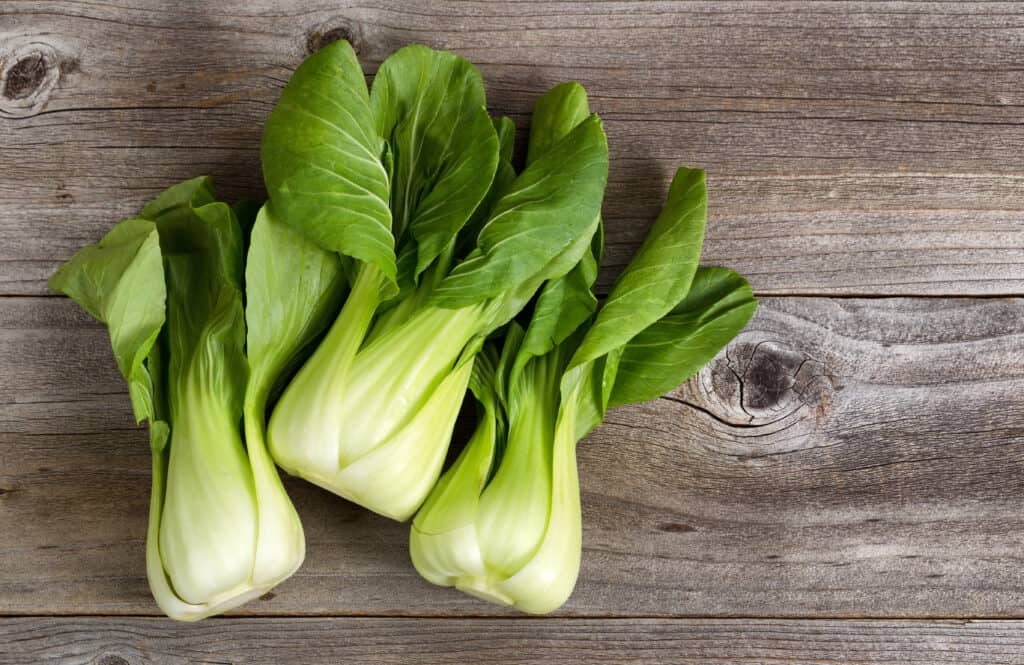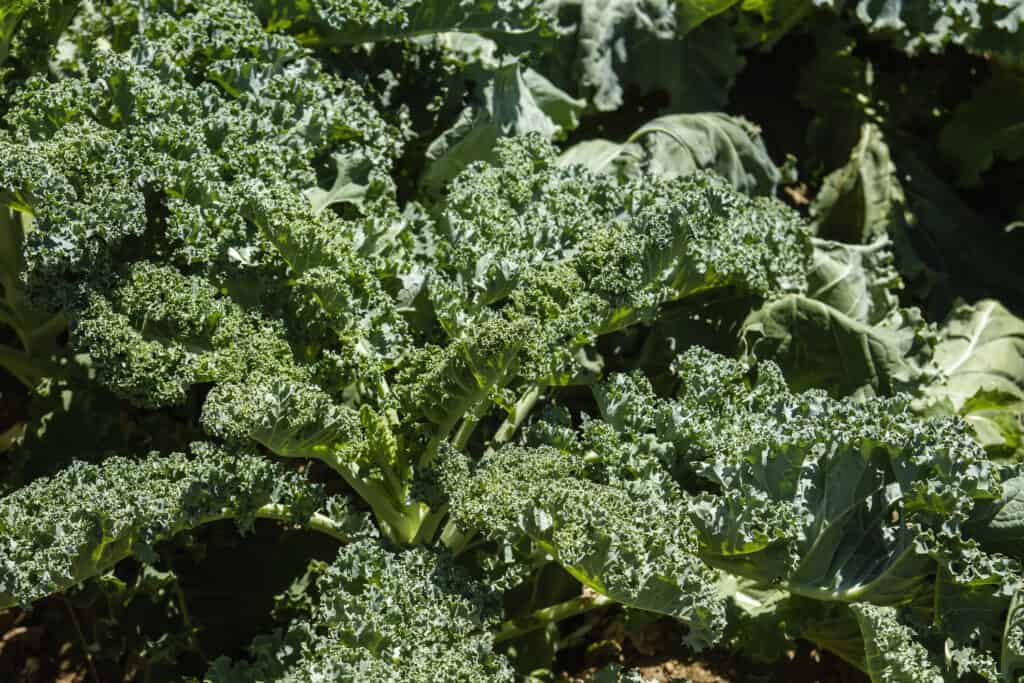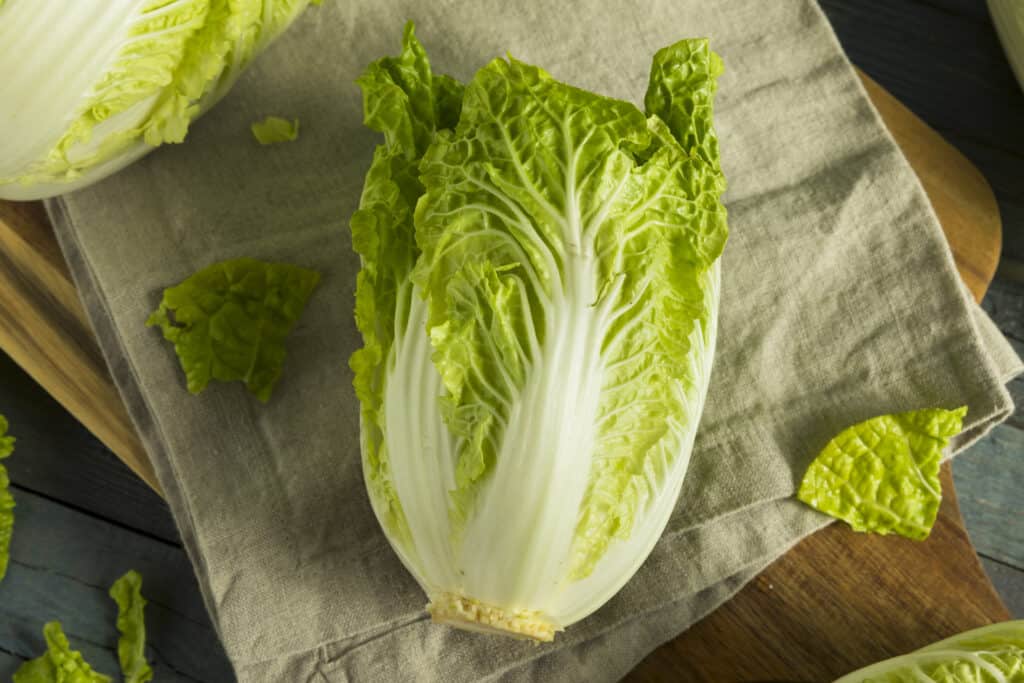Who doesn’t love a good brassica oleracea? This broad species of vegetables contain many of the typical gardener’s favorites, including kale and cabbage. But what are the real differences between kale and cabbage if they come from the same plant species? Believe it or not, there are many differences between these two plants. These differences shouldn’t deter you from one or the other, though. In fact, kale and cabbage grow very well together in the same garden and have many different uses.
Let’s take a look at what the real differences are between kale and cabbage, as well as why you should plant both in your own garden.
Comparing Kale vs. Cabbage

| Kale | Cabbage | |
|---|---|---|
| Classification | Brassica oleracea var. sabellica | Brassica oleracea var. capitata |
| Alternative Names | Cole, Leaf cabbage | Cole |
| Origin | Europe, Asia | Europe, Asia |
| Description | A member of the cabbage family with long rosette leaves and wavy margins | A leafy green biennial vegetable that grows in mild climates with a wide range of varieties and cultivars |
| Uses | Mainly used as food, and it is also known to help prevent heart disease | Mainly used as food, but it is also used to treat asthma and nausea |
| Growth Tips | Always space seedlings around two feet apart and always plant in full sun | Always plant in fertilized soil that drains well and stays moist |
| Interesting Features | Is an excellent source of vitamins and antioxidants | Has been cultivated around the world for over 4,000 years |
The Key Differences Between Kale and Cabbage
Cabbage and kale have many similarities, which makes sense considering the fact that they are both part of the same plant species brassica oleracea. This species contains many varieties and cultivars outside of cabbage and kale, such as broccoli, cauliflower, collard greens, and many more.
The differences between kale and cabbage are important, though. Kale plants contain green or purple leaves, and unlike headed cabbage, the center leaves do not condense into a head. The majority of the many domesticated varieties of Brassica oleracea are thought to be more closely related to wild cabbage than kale. Larger, flat leaves characterize cabbages. The leaves on kale are curlier. Compared to cabbage, kale typically maintains its color and form better.
In terms of nutrition, kale and cabbage differ slightly from one another. While both kale and cabbage are rich in dietary fiber and vitamin C, kale has a higher concentration of the carotenoids beta-carotene, lutein, and zeaxanthin. Niacin and riboflavin are more abundant in kale. Kale is well known for being a great source of calcium, potassium, vitamin A, and vitamin K. Alpha-carotene levels in kale and cabbage are comparable. With this information in mind, kale is somewhat more nutrient-dense than cabbage. In addition, kale tastes fresher, earthier, and greener than cabbage. It also has more anti-inflammatory properties than cabbage.
Kale vs. Cabbage: Classification
Kale and cabbage are the same species, brassica oleracea, which is part of the brassicaceae family. This species of plant has a wide range of different cultivars that are primarily used as cooking vegetables, including kale, cabbage, broccoli, cauliflower, brussels sprouts, collard greens, kohlrabi, and Chinese broccoli. In brassica oleracea’s uncultivated form, it is considered wild cabbage and a biennial plant. Out of all of the cultivars, kale is considered the closest to wild cabbage in form and nutrition.
Kale vs. Cabbage: Description

Cabbage can grow in prolonged sunshine conditions.
©tab62/Shutterstock.com
Cabbage is a leafy green, crimson, or white biennial plant farmed as an annual vegetable crop for its densely-leaved heads. It includes numerous varieties of brassica oleracea. Like kale, it is a descendant of wild cabbage. Green cabbages with smooth leaves and firm heads are the most prevalent, whereas purple cabbages with smooth leaves and savoy cabbages with crinkle-leafed varieties of both colors are less common. Cabbage can grow quite large in conditions of prolonged sunshine, such as those found in the summer in high northern latitudes.
In the mustard family of vegetables, which also includes broccoli and Brussels sprouts, kale is a cruciferous vegetable. Similar to cabbage, it can withstand extreme heat and cold temperatures when growing and has extremely robust leaves. This translates quite well in the kitchen because you can consume leafy greens all year long with kale, which may contribute to its popularity.
Kale vs. Cabbage: Uses

Kale can be used in place of potato chips by coating it in oil and baking.
©iStock.com/jessicahyde
Both kale and cabbage are primarily used for cooking. Kale can be used in recipes steamed, fried, roasted, raw, and everything in between. It can be blended up in smoothies for some added nutritional value or thrown into a soup to add some color and nutrients. Kale is also a popular food to use in lieu of potato chips by coating kale leaves in oil and baking them until crispy.
Cabbage is just as versatile in cooking as kale, if not more. Cabbage can be steamed, fried, baked, sautéd, and eaten raw. Raw cabbage is particularly popular for making coleslaws and other types of cold salad. Due to the large round leaves this plant produces, it can also be used as a low-carb substitute for tortillas or wraps.
Kale vs. Cabbage: Origin
Before 1000 BC, cabbage was likely domesticated in some parts of Europe. Since ancient times, cabbage has been used as a part of cuisine. In the Roman Empire, it was described as a table luxury. Cabbage had risen to prominence in European cuisine by the Middle Ages. From the Renaissance on, new variations were added, primarily by Germanic-speaking peoples. The 16th century saw the development of savoy cabbage. Central, northern, and eastern Europe adopted cabbage as a staple diet by the 17th and 18th centuries. During lengthy sea trips, it was also used by European sailors to avoid scurvy. Cabbage began to be exported to other countries in the Early Modern era.
As a wild cabbage ancestor, kale is a native of Asia Minor and Europe. It has been grown and eaten for around 4,000 years, according to historical records. However, kale’s history varies depending on location. Scottish kitchen gardens are known as kale yards because of the sheer quantity of kale that is cultivated there. Kale is dried and processed into a powder in Japan for use in green, nutritious drinks. Because it is such a hardy vegetable, kale was promoted as a victory crop in England during World War II. It has a very rich history and was likely transported around the world at the start of the Early Modern Era, along with cabbage.
Kale vs. Cabbage: How to Grow

Plants like kale grow very fast.
©Amverlly/Shutterstock.com
Plant kale three to five weeks prior to the final frost. Raised beds, containers, and in-ground gardens are all fantastic growth options. Kale should be planted in full sun with well-drained, nutritious soil, 18 to 24 inches apart. Add several inches of aged compost or other rich organic matter to the native soil to improve it. Kale grows quickly, so make sure the soil is consistently moist by giving it an inch of water each week. By routinely feeding plants with continuous-release plant food, you may maximize your crop. Consider an indoor, water-based growing system for kale if you want healthy produce all year long. Once the kale reaches the right color and size for eating, harvest it beginning with the lowest leaves. Once a light frost has caressed the leaves, they have reached the height of their flavor.
Similar, albeit slightly different, care is needed for cabbage. A full four weeks before the final frost, plant spring cabbage. Place your cabbage in a location that receives six or more hours of sun, following the instructions on the plant tag for spacing. Plant seeds and seedlings in fertile, well-drained soil at a depth of two inches. By incorporating several inches of compost or other rich organic matter, the native soil’s conditions can be improved.
Planting young plants with black plastic will help keep the soil warm and protect them from the cold. Give plants an inch of water once a week to water them consistently. By incorporating a slow-release plant food into the soil before planting, you may provide cabbage with a constant source of food. To aid in moisture retention and prevent weed growth, spread a three-inch layer of mulch over the area. When the cabbage head is firm, harvest it.
Kale vs. Cabbage: Special Features

Cabbage boosts the natural detoxifying process of the body.
©Brent Hofacker/Shutterstock.com
Cabbage is nutrient-rich. Red cabbage contains anthocyanins, which are polyphenols with anti-inflammatory and heart-healthy properties. Additionally, anthocyanins may assist improve vision and lower the risk of Parkinson’s disease. Isothiocyanates, which are found in cabbage, are effective anti-cancer substances that boost the body’s natural detoxifying processes. In the form of kimchi or sauerkraut, fermented cabbage is frequently consumed, and fermented foods have their own host of benefits. Probiotics, a type of beneficial bacteria that helps maintain gut health, are abundant in fermented foods.
Kale and cabbage are both special in that they have very good nutritional attributes. The plant-based phytonutrients, also known as phytochemicals, found in kale have been shown to have anti-cancer properties. These substances might lower the chance of developing chronic conditions including cancer and heart disease. Vitamin A, found in kale, promotes eye health so you can see better for longer. Kale has calcium, which is important for healthy bones, much like spinach does. It also contains a high amount of vitamin K, which promotes bone density and lowers the risk of fracture. Vitamin C, which promotes growth, immunity, and aids in wound healing, is abundant in kale. Consuming kale may also lower your risk of developing cardiovascular disease.
Please Note: A-Z Animals does not recommend plants or herbs for medicinal or health use. We present the following information for academic and historical purposes only.
To put it simply, both kale and cabbage are nutritious, versatile vegetables that complement virtually any diet. You can definitely pick one over the other to grow, but both of these plants grow well together in gardens. And who doesn’t like a little bit of variety?
Up Next:
- Red Kale vs. Green Kale: What Are the Differences?
- Kale vs. Lettuce: What Are Their Differences?
- Collard Greens vs Kale: What’s the Difference?
The photo featured at the top of this post is © Photour.1904/Shutterstock.com
FAQs (Frequently Asked Questions)
Are kale and cabbage nutritious?
Yes! Kale is lower in calories than other types of cabbage, but both have a high amount of vitamin K, vitamin C, and carbohydrates.
Is kale a type of cabbage?
Yes. Kale is part of the group brassica oleracea and is a cultivar designed to be edible as well as aesthetically useful for landscaping.
Does kale and cabbage have the same taste?
Compared to other cabbage varieties, kale tastes earthy, fresh, and sharp.
Thank you for reading! Have some feedback for us? Contact the AZ Animals editorial team.






